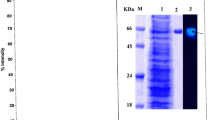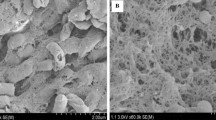Abstract
Thermomucor indicae-seudaticae was immobilized in alginate, κ-carrageenan, agarose, agar, polyacrylamide and loofah (Luffa cylindrica) sponge (as such or coated with alginate/starch/Emerson YpSs agar), and used for the production of glucoamylase in submerged fermentation. The mycelium developed from alginate-immobilized sporangiospores secreted higher glucoamylase titres (22.7 U ml−1) than those immobilized in other gel matrices and the freely growing mycelial pellets (18.5 U ml−1). Loofah network provided a good support for mycelial growth, but the enzyme production was lower than that attained with alginate beads. Glucoamylase production increased with inoculum density and the optimum levels were achieved when 40 calcium alginate beads (∼5 × 106 immobilized spores) were used to inoculate 50 ml production medium. The alginate bead inoculum displayed high storage stability at 4°C and produced comparable enzyme titres up to 120 days. The glucoamylase production by hyphae emerged from the immobilized sporangiospores was almost stable over eight batches of repeated fermentation. Scanning electron micrographs of alginate beads, after batch fermentation, revealed extensive mycelial growth inside and around the beads.







Similar content being viewed by others
References
Alteriis E, Silvestro G, Poletto M, Romano V, Capitanio D, Compagno C, Parascandola P (2004) Kluyveromyces lactis cells entrapped in Ca-alginate beads for the continuous production of a heterologous glucoamylase. J Biotechnol 109:83–92
Antranikian G (1992) Microbial degradation of starch. In: Winkel G (ed.), Microbial degradation of natural products. VCH Publishers, Germany, pp 27–51
Beshay U (2003) Production of alkaline protease by Teredinobacter turnirae cells immobilized in Ca-alginate beads. African J Biotechnol 2:60–65
Brink RH, Dubach P, Lynch DL (1960) Measurement of carbohydrate in soil hydrolases with anthrone. Soil Sci 89:157–166
Brodelius P, Vandamme EJ (1987) Immobilized cell systems. In: Rehm HJ, Reed G (eds), Biotechnology, vol 7a. VCH Verlagsgesellschaft, Germany, pp 403–463
Bucke C (1983) Immobilized cells. Phil Trans R Soc Lond B 300:369–389
Bucke C (1987) Cell immobilization in calcium alginate. In: Mosbach K (Ed.), Methods in enzymology, vol 135B. Academic press, New York, pp. 175–189
Crabb WD, Shetty JK (1999) Commodity scale production of sugars from starches. Curr Opin Microbiol 2:252–256
Ellaiah P, Prabhakar T, Ramakrishna B, Thaer Taleb A, Adinarayana K (2004) Production of lipase by immobilized cells of Aspergillus niger. Process Biochem 39:525–528
Emerson R (1941) An experimental study of life cycle and taxonomy of Allomyces. Lloydia 4:77–144
Federici F, Petruccioli M, Miller MW (1990a) Enhancement and stabilization of the production of glucoamylase by immobilized cells of Aureobasidium pullulans in a fluidized-bed reactor. Appl Microbiol Biotechnol 33:407–409
Federici RG, Federici F, Petruccioli M (1990b) Continuous production of glucoamylase by immobilized growing cells of Aureobasidium pullulans. Biotechnol Lett 12:661–666
Iqbal M, Edyvean RGJ (2004) Alginate coated loofa sponge discs for the removal of cadmium from aqueous solutions. Biotechnol Lett 26:165–169
Iqbal M, Zafar SI (1993) Bioactivity of immobilized microalgal cells: application potential of vegetable sponge in microbial biotechnology. Lett Appl Microbiol 17:289–291
Iqbal M, Zafar SI (1994) Vegetable sponge as a matrix to immobilize micro-organisms: a trial study for hyphal fungi, yeast and bacteria. Lett Appl Microbiol 18:214–217
Jamuna R, Ramakrishna V (1992) Continuous synthesis of thermostable α-amylase by Bacillus cells immobilized in calcium alginate. Enzyme Microb Technol 14:36–41
Kanlayakrit W, Ishimatsu K, Nakao M, Hayashida S (1987) Characteristics of raw starch digesting glucoamylase from thermophilic fungus Rhizomucor pusillus. J Ferment Technol 65:379–385
Kierstan MPJ, Bucke C (1977) The immobilization of microbial cells, subcellular organelles and enzymes in calcium alginate gels. Biotechnol Bioeng 19:387–397
Kierstan MPJ, Coughlan MP (1985) Immobilization of cells and enzymes by gel entrapment. In: Woodward J (Ed.), Immobilized cells and enzymes: a practical approach. IRL Press, Washington DC, pp 39–48
Kuek C (1991) Production of glucoamylase using Aspergillus phoenicus immobilized in calcium alginate beads. Appl Microbiol Biotechnol 35:466–470
Kumar S, Satyanarayana T (2003) Purification and kinetics of a raw starch-hydrolysing, thermostable and neutral glucoamylase of a thermophilic mould Thermomucor indicae-seudaticae. Biotechnol Prog 19:936–944
Li G-X, Linko Y-Y, Linko P (1984) Glucoamylase and α-amylase production by immobilized Aspergillus niger. Biotechnol Lett 6:645–650
Liu Y-K, Seki M, Tanaka H, Furusaki S (1998) Characteristics of loofa (Luffa cylindrica) sponge as a carrier for plant cell immobilization. J Ferment Bioeng 85:416–421
Meagher MM, Reilly PJ (1989) Kinetics of the hydrolysis of di- and trisaccharides by Aspergillus niger glucoamylses I and II. Biotechnol Bioeng 34:689–693
Miller GL (1959) Use of dinitrosalicylic acid reagent for determination of reducing sugar. Anal Chem 31:426–428
Norouzian D, Akbarzadeh A, Scharer JM, Young MM (2006) Fungal glucoamylases. Biotechnol Adv 24:80–85
Nunez MJ, Lema JM (1987) Cell immobilization: application to alcohol production. Enzyme Microb Technol 9:642–651
Ogbonna JC, Liu Y-C, Liu Y-K, Tanaka H (1994) Loofa (Luffa cylindrica) sponge as a carrier for microbial cell immobilization. J Ferment Bioeng 78:437–442
Ogbonna JC, Tomiyama S, Liu Y-C, Tanaka H (1997) Efficient production of ethanol by cells immobilized in loofa (Luffa cylindrica) sponge. J Ferment Bioeng 84:271–274
Pandey A, Nigam P, Soccol CR, Soccol VT, Singh D, Mohan R (2000) Advances in microbial amylases. Biotechnol Appl Biochem 31:135–152
Papagianni M, Joshi N, Moo-Young M (2002) Comparative studies on extracellular protease secretion and glucoamylase production by free and immobilized Aspergillus niger cultures. J Indust Microbiol Biotechnol 29:259–263
Polakovic M, Bryjak J (2004) Modelling of potato starch saccharification by an Aspergillus niger glucoamylase. Biochem Eng J 18:57–64
Rao VB, Sastri NV, Subba Rao PV (1981) Purification and characterization of a thermostable glucoamylase from the thermophilic fungus Thermomyces lanuginosus. Biochem J 193:379–387
Reilly PJ (1999) Protein engineering of glucoamylase to improve industrial performance-a review. Starch/Starke 51:269–274
Roble ND, Obgonna JC, Tanaka H (2003a) A novel circulating loop bioreactor with cells immobilized in loofa (Luffa cylindrica) sponge for the bioconversion of raw cassava starch to ethanol. Appl Microbiol Biotechnol 60:671–678
Roble ND, Obgonna JC, Tanaka H (2003b) l-Lactic acid production from raw cassava starch in a circulating loop bioreactor with cells immobilized in loofa (Luffa cylindrica). Biotechnol Lett 25:1093–1098
Saeed A, Muhammad I (2006) Immobilization of blue green microalgae on loofa sponge to biosorb cadmium in repeated shake flask batch and continuous flow fixed bed column reactor system. World J Microbiol Biotechnol 22:775–782
Satyanarayana T, Noorwez SM, Kumar S, Rao JLUM, Ezhilvannan M, Kaur P (2004) Development of an ideal starch saccharification process using amylolytic enzymes from thermophiles. Biochem Soc Trans 32:276–279
Slokoska LS, Angelova MB (1998) Immobilization of polymethylgalacturonase producing Aspergillus niger on Luffa sponge material. Z Naturforsch C 53:968–972
Subrahmanyam A, Mehrotra BS, Thirumalachar MJ (1977) Thermomucor, a new genus of Mucorales. Georgia J Sci 35:1–6
Tanaka H, Ohta T, Harada S, Ogboona JC, Yajima M (1994) Development of a fermentation method using immobilized cells under unsterile conditions: 1. Protection of immobilized cells against anti-microbial substances. Appl Microbiol Biotechnol 41:544–550
Thorsen TS, Johnsen AH, Josefsen K, Jensen B (2006) Identification and characterization of glucoamylase from the fungus Thermomyces lanuginosus. Biochem Biophys Acta 1764:671–676
Tosi LRO, Terenzi HF, Jorge JA (1993) Purification and characterization of an extracellular glucoamylase from the thermophilic Humicola grisea var. thermoidea. Can J Microbiol 39:846–852
Vignoli JA, Celligoi MAPC, Silva RSF (2006) Development of a statistical model for sorbitol production by free and immobilized Zymomonas mobilis in loofa sponge Luffa cylindrica. Process Biochem 41:240–243
Acknowledgements
We wish to thank University Grants Commission, Government of India for providing financial assistance during the course of this investigation, and Mr. Rajesh Pathania and Mr. Girish (All India Institute of Medical Sciences, New Delhi, India) for providing technical assistance in carrying out scanning electron microscopy of the alginate beads. Pardeep Kumar is also grateful to Council of Scientific and Industrial Research, Government of India for awarding Junior/Senior Research Fellowship.
Author information
Authors and Affiliations
Corresponding author
Rights and permissions
About this article
Cite this article
Kumar, P., Satyanarayana, T. Production of thermostable and neutral glucoamylase using immobilized Thermomucor indicae-seudaticae . World J Microbiol Biotechnol 23, 509–517 (2007). https://doi.org/10.1007/s11274-006-9253-y
Received:
Accepted:
Published:
Issue Date:
DOI: https://doi.org/10.1007/s11274-006-9253-y




